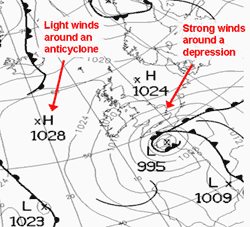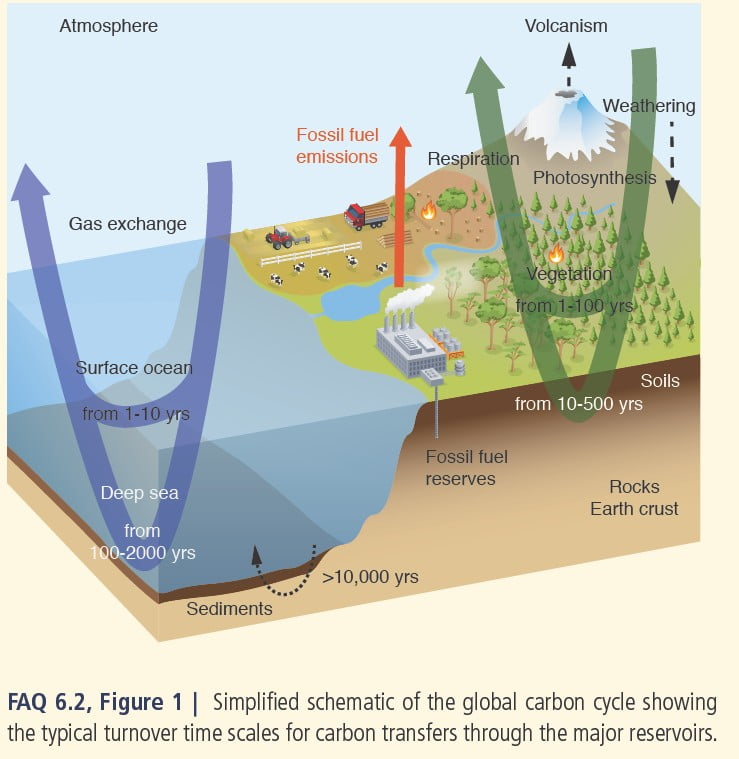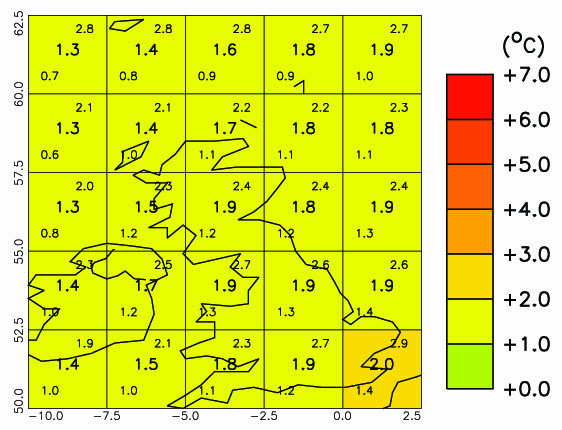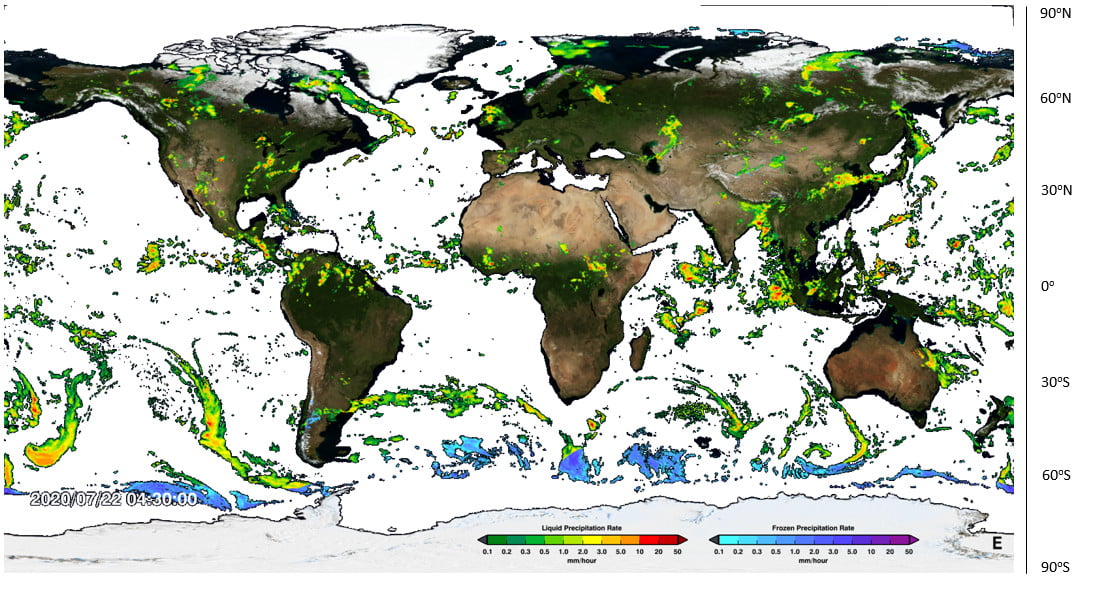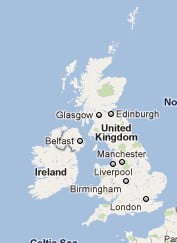Interpreting weather charts
Introduction
Weather systems
Fronts
Relationship between isobars and wind
Understanding station plots on a weather map
Plotting a station plot
Introduction
Weather charts consist of curved lines drawn on a geographical map in such a way as to indicate weather features. These features are best shown by charts of atmospheric pressure, which consist of isobars (lines of equal pressure) drawn around depressions (or lows) and anticyclones (or highs). Other features on a weather chart are fronts and troughs. These are drawn to highlight the areas of most significant weather, but that does not mean that there is nothing of significance elsewhere on the chart.
Weather systems
High pressure or anticyclones
Anticyclones are areas of high pressure, whose centres are often less well defined than depressions, and are associated with quiet, settled weather. Winds blow in a clockwise direction around anticyclones in the northern hemisphere, this is reversed in the southern hemisphere.
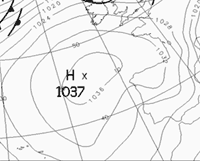
Low pressure or depressions
Depressions are areas of low pressure, usually with a well-defined centre, and are associated with unsettled weather. Winds blow in an anticlockwise direction around depressions in the northern hemisphere, this is reversed in the southern hemisphere.
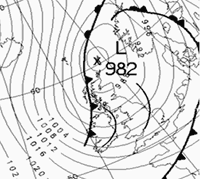
Fronts
Early weather charts consisted simply of station plots and isobars, with the weather being written as comments, like ‘Rain, heavy at times’. During the 1920s, a group of Scandinavian meteorologists, known collectively as the Bergen School, developed the concept of representing the atmosphere in terms of air masses. Since the air masses could be considered as being in conflict with each other, the term ‘front’ was used to describe the boundary between them. Three types of front were identified which depend on the relative movement of the air masses.
Cold Front
A cold front marks the leading edge of an advancing cold air mass. On a synoptic chart a cold front appear as a blue line with triangles. The direction in which the triangles point is the direction in which the front is moving.
Warm Front
A warm front marks the leading edge of an advancing warm air mass. On a synoptic chart a warm front appears as a red line with semi-circles. The direction in which the semi-circles point is the direction in which the front is moving.
Occlusion (or occluded front)
Occlusions form when the cold front of a depression catches up with the warm front, lifting the warm air between the fronts into a narrow wedge above the surface. On a synoptic chart an occluded front appears as a purple line with a combination of triangles and semi-circles. The direction in which the symbols point is the direction in which the front is moving.
Troughs
Fronts describe thermal characteristics. They also happen to be where there is significant precipitation. However, precipitation is not confined to fronts. Drizzle in warm sectors or showers in cold air occur fairly randomly, but occasionally, lines of more organised precipitation can develop. These are called troughs.
Isobars
Isobars are lines joining places with equal mean sea-level pressures (MSLP).
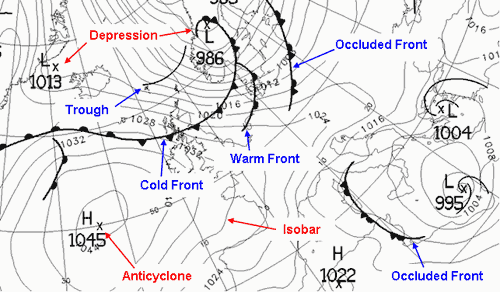
Relationship between isobars and wind
Understanding station plots on a weather map

Good quality observations are one of the basic ‘tools of the trade’ for a weather forecaster.
The weather conditions at each individual station can be represented on a surface chart by means of station plot.
This means that information which would take up a lot of space if written on to a chart can be displayed in a quick easy to understand format.
Figure 5 shows an example of a plotted chart.
The land station plot can represent all the elements reported from that station, these typically include:
|
|
Traditionally station plots for manned observing sites were based around a central station circle. However, increasingly, automatic weather observations are replacing these and being plotted on weather charts. To differentiate between the two, automatic observations are plotted around a station triangle. Each element of the observation, with the exception of wind, is plotted in a fixed position around the station circle or triangle so that individual elements can be easily identified.
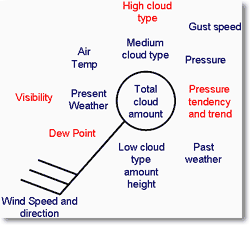
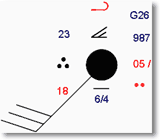
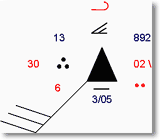
Plotting a station plot
Total cloud amount
The total amount of the sky covered by cloud is expressed in oktas (eighths) and is plotted within the station circle for manned observations or station triangle for automatic stations, by the amount of shading.
The symbols used for both manual and automatic observations are shown below.
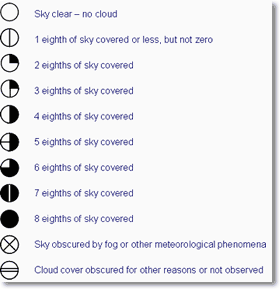
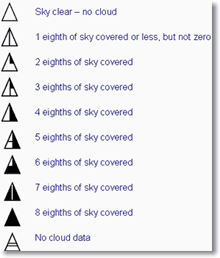
Wind speed and direction
The surface wind direction is indicated on the station plot by an arrow flying with the wind. Direction is measured in degrees from true North. Therefore a wind direction of 180 is blowing from the south. The wind speed is given by the number of ‘feathers’ on the arrow. Half feathers represent 5 knots whilst whole feathers indicate 10 knots. A wind speed of 50 knots is indicated by a triangle. Combinations of these can be used to report wind speed to the nearest 5 knots. The symbols used are as follows.
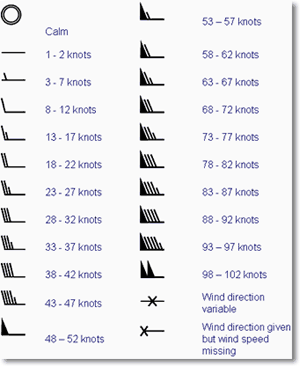
Air temperature
Air temperature is plotted to the nearest whole degree Celsius, i.e. 23 would indicate 23 degrees Celsius.
Dew point temperature
Dew point temperature is plotted to the nearest whole degree Celsius, i.e. 18 would indicate a dew point of 18 degrees Celsius.
Pressure
Pressure is recorded in millibars and tenths and the last three digits are plotted. Therefore 1003.1 would be plotted as 031 and 987.1 would be plotted as 871.
Present weather
In total the Met Office has 100 codes for recording the current weather at the time of the observation. Different types of weather are represented using different weather symbols, a key to which can be found below.
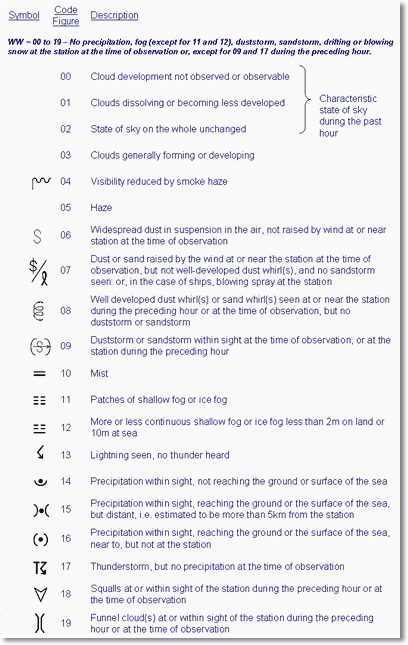

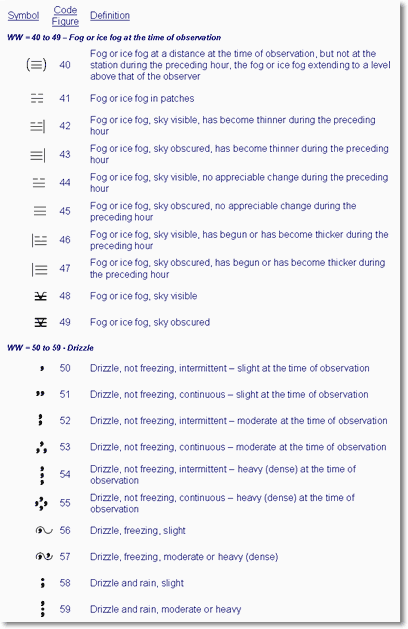


Past weather
A simplified version of the present weather plots is used to indicate past weather.
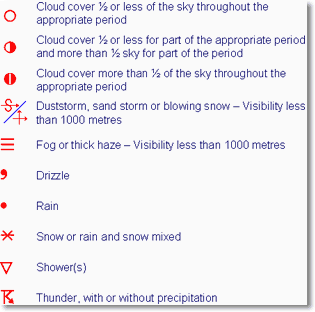
Pressure Tendency
Pressure trend shows how the pressure has changed during the past three hours, i.e rising or falling, and pressure tendency shows by how much it has changed. The tendency is given in tenths of a millibar, therefore ’20’ would indicate a change of two millibars in the last three hours. Pressure tendency is indicated by the following symbols.
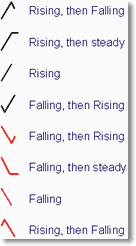
Visibility
Visibility, which is how far we can see, is given in coded format, in either meters or kilometres. Visibilities below five kilometres are recorded to the nearest 100 metres, whilst those above five kilometres are given to the nearest kilometre.
For visibilities equal to and less than five km:
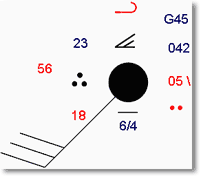
|
For visibilities greater than five km:
|
Low cloud type
The type of low cloud present is provided in coded format, using the symbols below.

Medium cloud type
The type of medium cloud present is provided in coded format, using the symbols below.
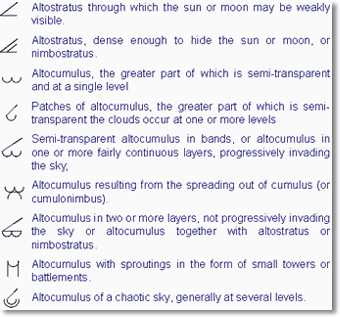
High cloud type
The type of high cloud present is provided in coded format, using the symbols below.
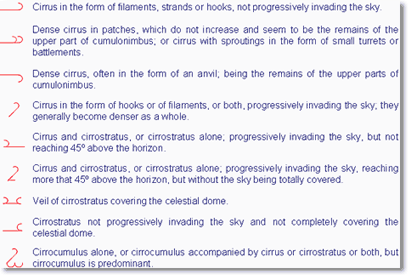
Cloud height
Cloud heights are measured in hundreds or thousands of feet. The way these are plotted varies depending on whether the station is an automatic or manned observing site.
For automatic stations, indicated by a station triangle, the following codes are used.
|
For manned stations, indicated by a station circle, the following codes are used.
|
Gust speed
Gust speeds are measured in knots and proceeded by the letter G. Gust speeds are normally only recorded if they exceed 25 knots and are plotted as whole knots, i.e. G35 indicates a gust of 35 knots.
Example
The decode of this station plot is as follows:

Type of observation: | Manned |
Total cloud amount: | 8 oktas |
Wind Speed: | 28-32 knots |
Wind direction: | South-westerly |
Air temperature: | 23 degrees Celsius |
Dew point temperature: | 18 degrees Celsius |
Pressure: | 1004.2 millibars |
Present weather: | Continuous moderate rain |
Past weather: | Rain |
Pressure tendency: | Falling 0.5 millibars in the past three hours |
Visibility: | 6km |
Low cloud type: | Stratus |
Low cloud amount: | 6 oktas |
Low cloud height: | 1000 feet |
Medium cloud type: | Altostratus |
High cloud type: | Cirrus |
Gust speed: | 45 knots |
Exercise
Why not try decoding the following observational plots.
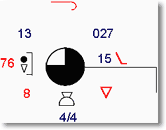
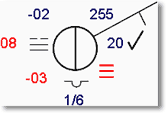
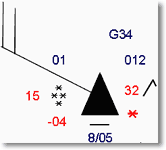
Web page reproduced with the kind permission of the Met Office
